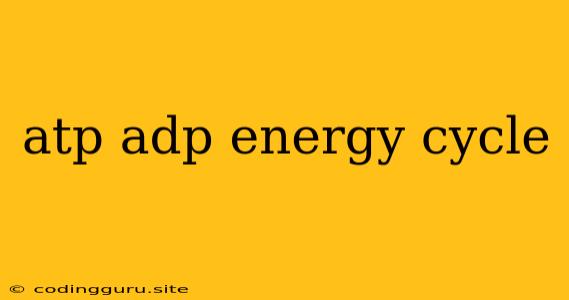The ATP-ADP Cycle: The Energy Currency of Life
Life is a constant dance of energy, and at the heart of this dance lies the ATP-ADP cycle. This remarkable process is the fundamental mechanism by which energy is stored and released in living organisms, fueling all cellular activities, from muscle contraction to protein synthesis.
What is ATP and ADP?
ATP (adenosine triphosphate) is often referred to as the "energy currency" of cells. It's a molecule composed of adenine, ribose, and three phosphate groups. The key to ATP's energy-carrying capacity lies in the high-energy bonds between these phosphate groups.
ADP (adenosine diphosphate), on the other hand, is the same molecule but with only two phosphate groups. When one of the phosphate groups is removed from ATP, energy is released, converting ATP to ADP. This released energy is used by the cell to perform its functions.
The ATP-ADP Cycle: A Simple Analogy
Imagine a rechargeable battery. The fully charged battery is like ATP, storing a lot of energy. When you use the battery to power a device, it discharges, releasing energy. This discharged state is like ADP. To recharge the battery, you need to add energy back into it. Similarly, to convert ADP back to ATP, energy is required.
Where Does the Energy Come From?
The energy required to convert ADP back to ATP comes from various sources:
- Cellular Respiration: This process breaks down glucose to produce ATP, using oxygen.
- Photosynthesis: Plants use sunlight to convert carbon dioxide and water into glucose, which is then used to produce ATP.
- Other Metabolic Processes: Some reactions within the cell release energy that can be used to create ATP.
How Does the ATP-ADP Cycle Work?
- Energy is Released: When a cell needs energy, an enzyme called ATPase breaks the high-energy bond between the last two phosphate groups in ATP. This releases energy and converts ATP into ADP and an inorganic phosphate (Pi).
- Energy is Added: The released energy is used to power cellular processes. ADP and Pi then combine to form ATP, requiring an input of energy.
- The Cycle Continues: This continuous cycle of ATP being broken down and then reformed allows cells to constantly access and utilize energy.
Why is the ATP-ADP Cycle Important?
The ATP-ADP cycle is crucial for life because it enables cells to:
- Perform Work: From muscle contractions to protein synthesis, all cellular work requires energy, which is supplied by ATP.
- Maintain Homeostasis: Cells require a constant supply of energy to maintain their internal environment and function optimally.
- Adapt to Changes: The ATP-ADP cycle enables cells to respond to environmental changes, such as temperature fluctuations or nutrient availability.
Examples of the ATP-ADP Cycle in Action
Here are some examples of how the ATP-ADP cycle powers various cellular functions:
- Muscle Contraction: Muscle fibers use ATP to slide protein filaments past each other, causing muscle contraction.
- Active Transport: ATP powers pumps that move substances across cell membranes against their concentration gradients.
- Nerve Impulses: ATP is used to establish and maintain the electrical potential across nerve cell membranes, enabling the transmission of nerve impulses.
- Protein Synthesis: ATP provides energy for the formation of peptide bonds during protein synthesis.
Tips for Understanding the ATP-ADP Cycle
- Visualize the process: Using diagrams and animations can help you understand the flow of energy during the ATP-ADP cycle.
- Relate it to real-life examples: Think of how you use energy for daily activities and how that relates to the way cells utilize ATP.
- Focus on the key components: Remember the structure of ATP and ADP and how the energy bonds play a crucial role.
- Connect it to other biological processes: Understand how the ATP-ADP cycle is linked to cellular respiration, photosynthesis, and other metabolic pathways.
Conclusion
The ATP-ADP cycle is a fundamental principle in biology, providing the energy that powers all cellular processes. Understanding this cycle is essential for appreciating the intricacies of life and the remarkable efficiency of cellular energy management.
